

Compact Muon Solenoid
LHC, CERN
| CMS-PAS-BPH-18-005 | ||
| Study of the B+→J/ψˉΛp decay in proton-proton collisions at √s= 8 TeV | ||
| CMS Collaboration | ||
| March 2019 | ||
| Abstract: A study of the B+→J/ψˉΛp decay is reported, using proton-proton collision data collected at √s= 8 TeV by the CMS experiment at the LHC, corresponding to an integrated luminosity of 19.6 fb−1. The ratio of branching fractions B(B+→J/ψˉΛp)/B(B+→J/ψK∗+) is measured to be 1.054 ± 0.057 (stat) ± 0.028 (syst) ± 0.011 (B)%, where the first uncertainty is statistical, the second is systematic, and the third reflects the uncertainties in the world-average branching fractions. The invariant mass distributions of J/ψˉΛ, J/ψp, and ˉΛp systems produced in the B+→J/ψˉΛp decay are investigated and found to be inconsistent with the pure phase space hypothesis. The analysis is extended by using a model-independent angular amplitude analysis, which shows that the inclusion of contributions from excited kaons in the ˉΛp system does improve the description of the observed invariant mass distributions. | ||
|
Links:
CDS record (PDF) ;
CADI line (restricted) ;
These preliminary results are superseded in this paper, JHEP 12 (2019) 100. The superseded preliminary plots can be found here. |
||
| Figures | |
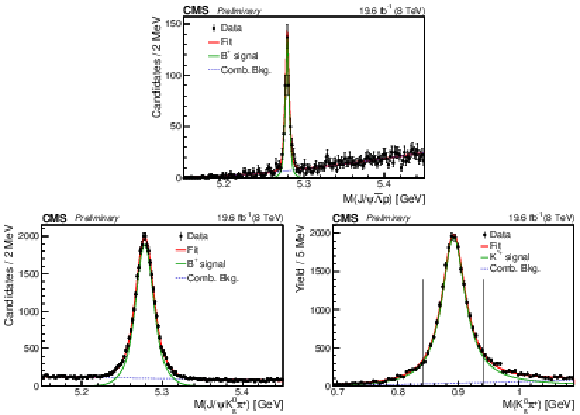
png pdf |
Figure 1:
Invariant mass distribution of the selected B+→J/ψ¯Λp candidates (upper). The J/ψK0Sπ+ (lower left) and K0Sπ+ (lower right) invariant mass distributions in the B+→J/ψK∗+ decay. The points are data and the curves are results of the fits described in the text. The vertical lines in the last plot indicate the K∗+ invariant mass window used for the normalization, as described in the text. |
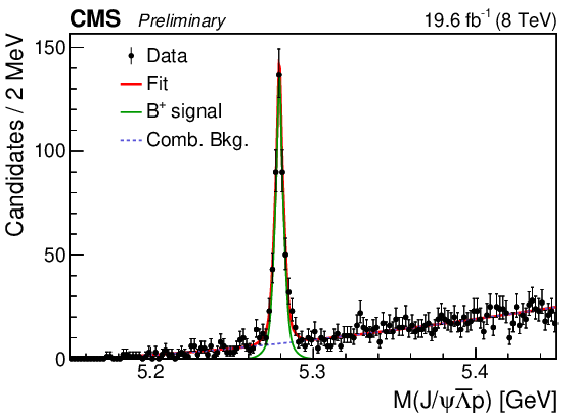
png pdf |
Figure 1-a:
Invariant mass distribution of the selected B+→J/ψ¯Λp candidates. The points are data and the curves are results of the fits described in the text. |

png pdf |
Figure 1-b:
The J/ψK0Sπ+ invariant mass distribution in the B+→J/ψK∗+ decay. The points are data and the curves are results of the fits described in the text. |
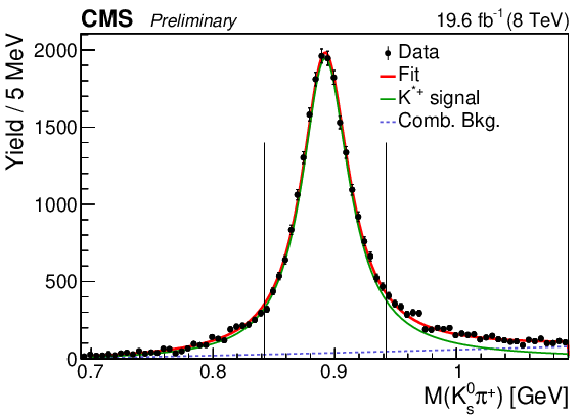
png pdf |
Figure 1-c:
The K0Sπ+ invariant mass distribution in the B+→J/ψK∗+ decay. The points are data and the curves are results of the fits described in the text. The vertical lines indicate the K∗+ invariant mass window used for the normalization, as described in the text. |
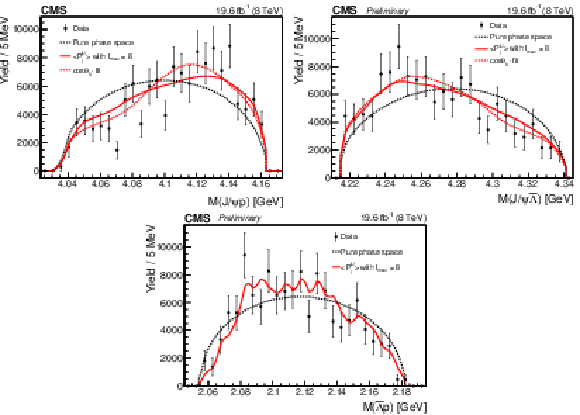
png pdf |
Figure 2:
The invariant mass distributions of the J/ψp (upper left), J/ψ¯Λ (upper right), and ¯Λp (lower) systems from the B+→J/ψ¯Λp decay. The points are efficiency-corrected and background-subtracted data. Superimposed curves are obtained from simulation: the red curve represents the phase space distribution corrected by the ¯Λp angular structure with the inclusion of the first eight moments corresponding to the resonances in the ¯Λp system with the maximum spin S=4; the dashed red curve is the fit to the phase space distribution reweighted according to the 1D cosθK∗ distribution, which is defined as the H1 hypothesis and explained in Section 8.3; the black dashed line corresponds to the pure phase space fit. |
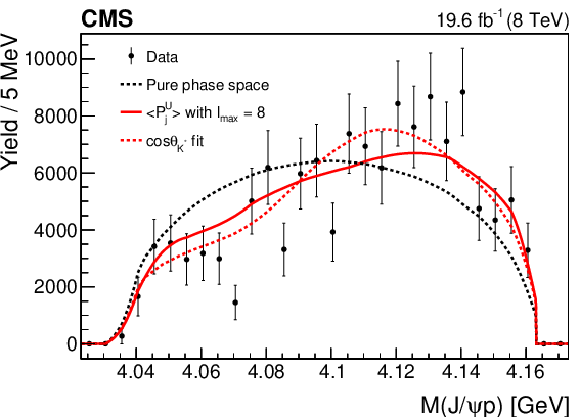
png pdf |
Figure 2-a:
The invariant mass distribution of the J/ψp system from the B+→J/ψ¯Λp decay. The points are efficiency-corrected and background-subtracted data. Superimposed curves are obtained from simulation: the red curve represents the phase space distribution corrected by the ¯Λp angular structure with the inclusion of the first eight moments corresponding to the resonances in the ¯Λp system with the maximum spin S=4; the dashed red curve is the fit to the phase space distribution reweighted according to the 1D cosθK∗ distribution, which is defined as the H1 hypothesis and explained in Section 8.3; the black dashed line corresponds to the pure phase space fit. |
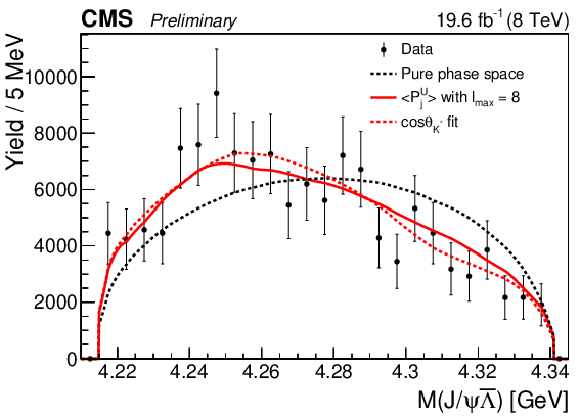
png pdf |
Figure 2-b:
The invariant mass distribution of the J/ψ¯Λ system from the B+→J/ψ¯Λp decay. The points are efficiency-corrected and background-subtracted data. Superimposed curves are obtained from simulation: the red curve represents the phase space distribution corrected by the ¯Λp angular structure with the inclusion of the first eight moments corresponding to the resonances in the ¯Λp system with the maximum spin S=4; the dashed red curve is the fit to the phase space distribution reweighted according to the 1D cosθK∗ distribution, which is defined as the H1 hypothesis and explained in Section 8.3; the black dashed line corresponds to the pure phase space fit. |
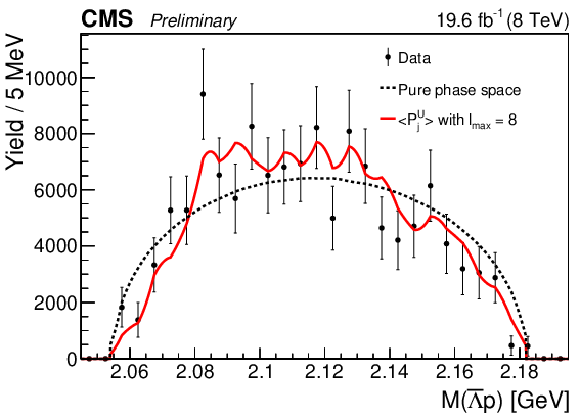
png pdf |
Figure 2-c:
The invariant mass distribution of the ¯Λp system from the B+→J/ψ¯Λp decay. The points are efficiency-corrected and background-subtracted data. Superimposed curves are obtained from simulation: the red curve represents the phase space distribution corrected by the ¯Λp angular structure with the inclusion of the first eight moments corresponding to the resonances in the ¯Λp system with the maximum spin S=4; the dashed red curve is the fit to the phase space distribution reweighted according to the 1D cosθK∗ distribution, which is defined as the H1 hypothesis and explained in Section 8.3; the black dashed line corresponds to the pure phase space fit. |

png pdf |
Figure 3:
The illustration of decay angles in B+→J/ψ¯Λp decay. |

png pdf |
Figure 4:
The background-subtracted and efficiency-corrected cos(θK∗) distribution on data and simulation. |

png pdf |
Figure 5:
The dependence of first unnormalized Legendre moments on M(¯Λp). |

png pdf |
Figure 5-a:
The dependence of the first unnormalized Legendre moment on M(¯Λp). |
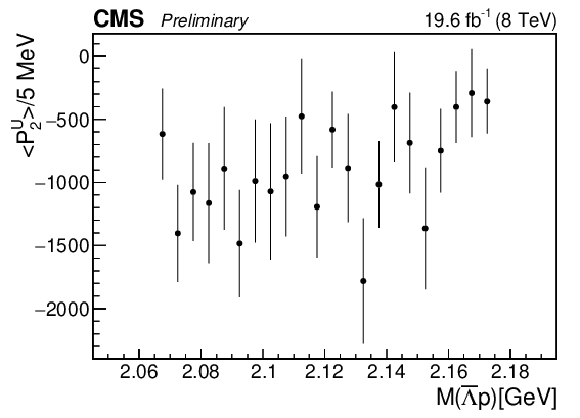
png pdf |
Figure 5-b:
The dependence of the second unnormalized Legendre moment on M(¯Λp). |
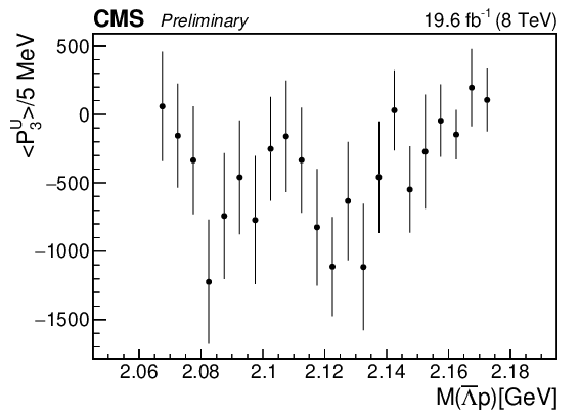
png pdf |
Figure 5-c:
The dependence of the third unnormalized Legendre moment on M(¯Λp). |

png pdf |
Figure 5-d:
The dependence of the fourth unnormalized Legendre moment on M(¯Λp). |
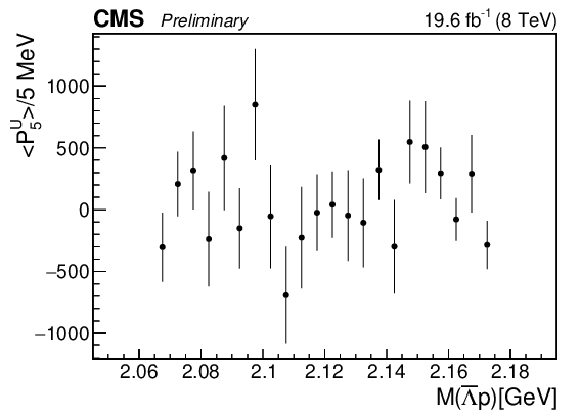
png pdf |
Figure 5-e:
The dependence of the fifth unnormalized Legendre moment on M(¯Λp). |
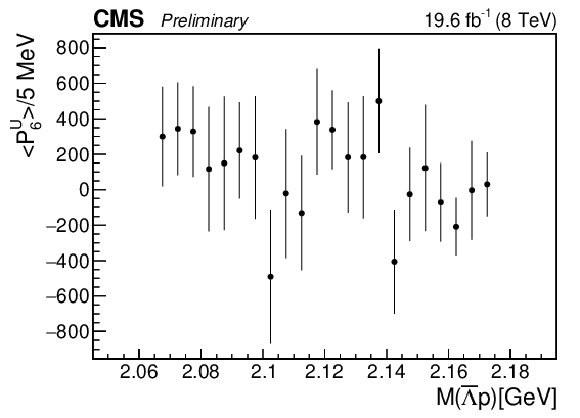
png pdf |
Figure 5-f:
The dependence of the sixth unnormalized Legendre moment on M(¯Λp). |
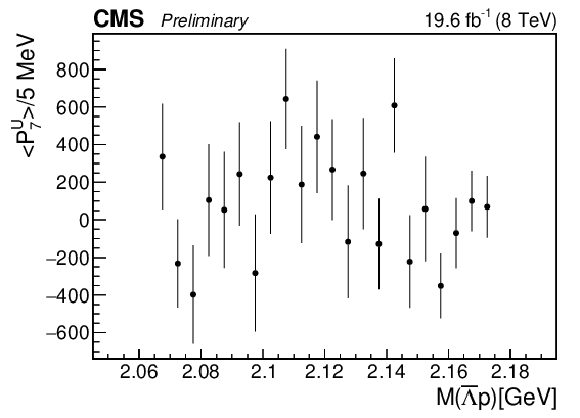
png pdf |
Figure 5-g:
The dependence of the seventh unnormalized Legendre moment on M(¯Λp). |
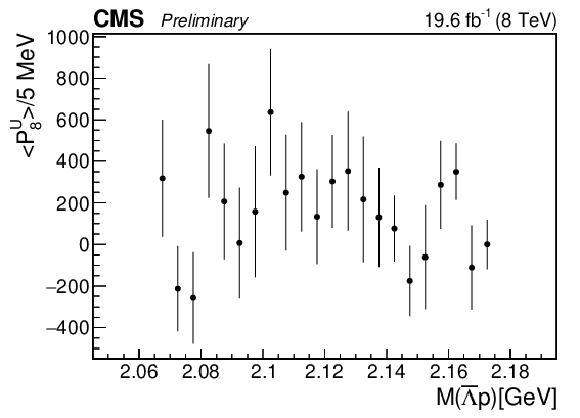
png pdf |
Figure 5-h:
The dependence of the eighth unnormalized Legendre moment on M(¯Λp). |
| Tables | |

png pdf |
Table 1:
Summary of the relative systematic uncertainties in the B(B+→J/ψ¯Λp)/B(B+→J/ψK∗+) ratio. |

png pdf |
Table 2:
Known excited K∗ states [3] that can decay to ¯Λp. |
| Summary |
| Using the data set of proton-proton collisions, collected by the CMS experiment at √s= 8 TeV and corresponding to an integrated luminosity of 19.6 fb−1, we measured the branching fraction ratio B(B+→J/ψˉΛp)/B(B+→J/ψK∗+)= (1.054 ± 0.057 (stat) ± 0.028 (syst) ± 0.011 (B) )×10−2. Using the world-average branching fraction of the B+→J/ψK∗+ decay, we obtained B(B+→J/ψˉΛp)= (15.07 ± 0.81 (stat) ± 0.40 (syst) ± 0.86 (B) )×10−6. The study of two-body invariant mass distributions of the B+→J/ψˉΛp decay products was performed, showing that the spectra can not be satisfactory modeled with a phase space distribution. The incompatibility with the phase space hypothesis is more than 5.5, 6, and 3.4 standard deviations for the J/ψˉΛ, J/ψp, and ˉΛp mass spectra, respectively. A model-independent approach was used to conclude that the agreement is improved significantly, and is within three standard deviations, once the contribution from K∗ resonances with spins up to 4 in the ˉΛp system is accounted for. |
| References | ||||
| 1 | BaBar Collaboration | Evidence for B+→J/ψp¯Λ and search for B0→J/ψpˉp | PRL 90 (2003) 231801 | hep-ex/0303036 |
| 2 | Belle Collaboration | Observation of B−→J/ψΛˉp and searches for B−→J/ψΣ0ˉp and B0→J/ψpˉp decays | PRD 72 (2005) 051105 | hep-ex/0508011 |
| 3 | Particle Data Group Collaboration | Review of Particle Physics | PRD 98 (2018) 030001 | |
| 4 | S. J. Brodsky and F. S. Navarra | Looking for exotic multi - quark states in nonleptonic B decays | PLB 411 (1997) 152 | hep-ph/9704348 |
| 5 | CLEO Collaboration | Inclusive decays of B mesons to charmonium | PRD 52 (1995) 2661 | |
| 6 | BaBar Collaboration | Study of inclusive production of charmonium mesons in B decay | PRD 67 (2003) 032002 | hep-ex/0207097 |
| 7 | M. Beneke, G. A. Schuler, and S. Wolf | Quarkonium momentum distributions in photoproduction and B decay | PRD 62 (2000) 034004 | hep-ph/0001062 |
| 8 | Belle Collaboration | Search for B−→J/ψΛˉp decay | PRD 69 (2004) 017101 | hep-ex/0309060 |
| 9 | LHCb Collaboration | First observation of a baryonic B+c decay | PRL 113 (2014) 152003 | 1408.0971 |
| 10 | LHCb Collaboration | Searches for B0(s)→J/ψpˉp and B+→J/ψpˉpπ+ decays | JHEP 09 (2013) 006 | 1306.4489 |
| 11 | LHCb Collaboration | Observation of B0(s)→J/ψp¯p decays and precision measurements of the B0(s) masses | 1902.05588 | |
| 12 | LHCb Collaboration | Observation of J/ψp resonances consistent with pentaquark states in Λ0b→J/ψK−p decays | PRL 115 (2015) 072001 | 1507.03414 |
| 13 | LHCb Collaboration | Observation of the Ξ−b→J/ψΛK− decay | PLB 772 (2017) 265 | 1701.05274 |
| 14 | CMS Collaboration | Description and performance of track and primary-vertex reconstruction with the CMS tracker | JINST 9 (2014) P10009 | CMS-TRK-11-001 1405.6569 |
| 15 | CMS Collaboration | Performance of cms muon reconstruction in pp collision events at √s= 7 TeV | JINST 7 (2012) P10002 | CMS-MUO-10-004 1206.4071 |
| 16 | CMS Collaboration | The CMS trigger system | JINST 12 (2017) P01020 | CMS-TRG-12-001 1609.02366 |
| 17 | CMS Collaboration | The CMS experiment at the CERN LHC | JINST 3 (2008) S08004 | CMS-00-001 |
| 18 | CMS Collaboration | Description and performance of track and primary-vertex reconstruction with the CMS tracker | JINST 9 (2014) P10009 | CMS-TRK-11-001 1405.6569 |
| 19 | CMS Collaboration | CMS tracking performance results from early LHC operation | EPJC 70 (2010) 1165 | CMS-TRK-10-001 1007.1988 |
| 20 | T. Sjostrand, S. Mrenna, and P. Skands | PYTHIA 6.4 physics and manual | JHEP 05 (2006) 026 | hep-ph/0603175 |
| 21 | D. J. Lange | The EVTGEN particle decay simulation package | NIMA 462 (2001) 152 | |
| 22 | S. Agostinelli et al. | GEANT4 -- a simulation toolkit | NIMA 506 (2003) 250 | |
| 23 | M. Pivk and F. R. Le Diberder | SPlot: A statistical tool to unfold data distributions | NIMA 555 (2005) 356 | physics/0402083 |
| 24 | M. J. Oreglia | A study of the reactions ψ′→γγψ | PhD thesis, Stanford University, 1980 SLAC Report SLAC-R-236, see Appendix D | |
| 25 | J. Gaiser | Charmonium Spectroscopy From Radiative Decays of the J/ψ and ψ′ | PhD thesis, SLAC | |
| 26 | BaBar Collaboration | Search for the Z(4430)− at BaBar | PRD 79 (2009) 112001 | 0811.0564 |
| 27 | LHCb Collaboration | Model-independent confirmation of the Z(4430)− state | PRD 92 (2015) 112009 | 1510.01951 |
| 28 | LHCb Collaboration | Model-independent evidence for J/ψp contributions to Λ0b→J/ψpK− decays | PRL 117 (2016) 082002 | 1604.05708 |

|
Compact Muon Solenoid LHC, CERN |

|

|

|

|

|

|